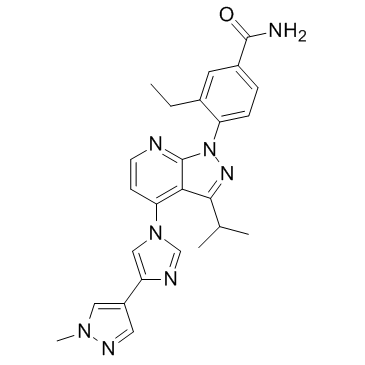TAS-116 (Synonyms: TAS-116) |
| Catalog No.GC33286 |
TAS-116 (TAS-116) is an oral bioavailable, ATP-competitive, highly specific HSP90α/HSP90β inhibitor (Kis of 34.7 nM and 21.3 nM, respectively) without inhibiting other HSP90 family proteins such as GRP94. TAS-116 demonstrates less ocular toxicity.
Products are for research use only. Not for human use. We do not sell to patients.

Cas No.: 1260533-36-5
Sample solution is provided at 25 µL, 10mM.
TAS-116 is an oral bioavailable, ATP-competitive, highly specific HSP90α/HSP90β inhibitor (Kis of 34.7 nM and 21.3 nM, respectively) without inhibiting other HSP90 family proteins such as GRP94[1]. TAS-116 demonstrates less ocular toxicity[2].
TAS-116 binds not only to the conventional-binding pockets as existing Hsp-90 inhibitors, but also to a novel-binding pocket. Such a unique binding mode makes TAS-116 highly specific for Hsp-90α/β without inhibiting other Hsp-90 family proteins such as GRP94 in endoplasmic reticulum or TRAP-1 in mitochondria[3].TAS-116 (0-5 μM, 48 hours) inhibits human retinal pigment epithelial ARPE-19 cell lines and NCI-H929 MM cells growth[2].More significant degradation of p-C-Raf and p-MEK1/2, HSP90 client proteins and key RAS/RAF/MEK pathway regulators, is triggered by TAS-116 (0.125-1 μM, 24 hours) than 17-AAG in INA6 and NCI-H929 MM cells[2].|| Cell Viability Assay[2]||Cell Line:|Human retinal pigment epithelial ARPE-19 cell lines and NCI-H929 MM cells|Concentration:|0-5 μM|Incubation Time:|48 hours|Result:|Inhibited NCI-H929 MM cells growth with an IC50 of 0.35 μM.|| Western Blot Analysis[2]||Cell Line:|MM cell lines INA6 and NCI-H929 cells|Concentration:|0.125-1 μM|Incubation Time:|24 hours|Result:|Targeted potently HSP90 client proteins including C-Raf and MEK1/2; as well as inhibited upregulation of HSP27 and overcomes 17-AAG resistance mechanisms.
TAS-116 (12.0 mg/kg, p.o., 14 days) shows antitumor activity without inducing eye injury in rats. TAS-116 is distributed less in retina than in plasma in rats; consequently, TAS-116 does not produce any detectable photoreceptor injury[1]. TAS-116 triggers enhanced in vivo anti-MM activities, both alone and in combination with Bortezomib (BTZ), with a favorable safety profile. Mice treated with TAS-116 (10 mg/kg and 15 mg/kg, orally, 38 days), BTZ, or TAS-116 plus BTZ show significantly enhance growth inhibition versus the vehicle control group. Median overall survival of treated animals (TAS-116, orally, 10 mg/kg=33 days, 15 mg/kg=37 days, BTZ=36 days, and the combination=56.5 days) is significantly longer than vehicle control[2]. The favorable pharmacokinetic profile of TAS-116 is reflected in its dose-dependent antitumor activity; the T/C (tumor volume of TAS-116-treated mice vs. vehicle-treated mice) is 47%, 21%, and 9% for doses of 3.6 mg/kg, 7.1 mg/kg, and 14.0 mg/kg, respectively. TAS-116 is orally absorbed and has a bioavailability of almost 100% in mice, and 69.0% in rats. TAS-116 has moderate terminal elimination half-life (t1/2=8.2 h, 2.5 h, 4.4 h and 2.2 h for mouse (3.6 mg/kg, p.o.), mouse (7.1 mg/kg, p.o.), mouse (14.0 mg/kg, p.o.), rat (4 mg/kg, p.o.)). TAS-116 is more rapidly eliminated from retina (t1/2=3.4 hours) than the other HSP90 inhibitors (t1/2=7.1-19.1 hours)[1].|| Animal Model:|Male F344 nude rats (6 weeks old) with established NCI-H1975 xenografts (6 weeks old)[1]|Dosage:|12.0 mg/kg|Administration:|Oral administration; daily; two weeks|Result:|Led to tumor shrinkage. Showed antitumor activity without inducing eye injury in rats and did not cause ocular toxicity at the effective dose in the NCI-H1975 rat xenograft model.|| Animal Model:|CB17 SCID mice (48-54 days old) with murine xenograft model[2]|Dosage:|10 and 15 mg/kg|Administration:|Oral administration; 5 days a week; for 28 days|Result:|Enhanced significantly growth inhibition versus the vehicle control group. The delay in tumor growth was greater in the combination-treated group compared with either monotherapy cohort.|| Animal Model:|Mice, Rats, and Dogs[1]|Dosage:|3.0 mg/kg for dogs, 4.0 mg/kg for rats, 3.6, 7.1 and 14.0 mg/kg for mice|Administration:|Oral administration; daily; 20 days|Result:|Absorbed orally and had a bioavailability of almost 100% in mice, 69.0% in rats, and 73.9% in dogs without special formulation.
[1]. Ohkubo S, et al. TAS-116, a highly selective inhibitor of heat shock protein 90α and β, demonstrates potent antitumor activity and minimal ocular toxicity in preclinical models. Mol Cancer Ther. 2015 Jan;14(1):14-22. [2]. Suzuki R, et al. Anti-tumor activities of selective HSP90α/β inhibitor, TAS-116, in combination with bortezomib in multiple myeloma. Leukemia. 2015 Feb;29(2):510-4. [3]. Utsugi T. New challenges and inspired answers for anticancer drug discovery and development. Jpn J Clin Oncol. 2013 Oct;43(10):945-53.
Average Rating: 5 (Based on Reviews and 4 reference(s) in Google Scholar.)
GLPBIO products are for RESEARCH USE ONLY. Please make sure your review or question is research based.
Required fields are marked with *




















